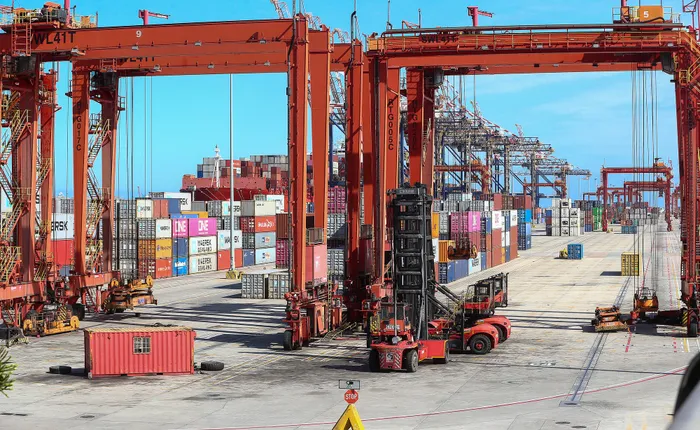Inefficiencies plague Durban's port: Insights from the 2024 Container Port Performance Index

The latest World Bank report highlights the Port of Durban's troubling performance, ranking it among the worst in the world
Image: Leon Lestrade / Independent Newspapers
The latest World Bank report on the efficiency of container ports worldwide has again painted a troubling picture of the Port of Durban’s performance. The fifth edition of the Container Port Performance Index (CPPI) for 2024, released recently, ranks Durban as the 403rd busiest port globally, placing it among the worst performers in the world.
So grim is the picture, South Africa could not take advantage of the shipping crises in other parts of the world because of the inefficiencies in its port. Despite this dismal ranking, the report indicates that investments have been made to improve the situation, with some positive signs emerging.
Logistics and labour experts have expressed concern, stating that the findings reveal a dire state of the ports, which continue to act as a stumbling block for the economy. Transnet, the state-owned company responsible for South Africa's transport and logistics infrastructure, has pushed back against these findings, highlighting that the report also noted several improvements in the performance of their ports.
The CPPI, prepared jointly by the Transport Global Practice of the Infrastructure Vice-Presidency at the World Bank and the Global Insight division of S&P Global Market Intelligence, serves as a diagnostic and planning tool. Its aim is not to benchmark ports against one another but to help port authorities, governments, and private stakeholders identify areas for improvement and the conditions necessary for such advancements.
The CPPI measures the time container ships spend in port, making it a crucial reference point for stakeholders in the global economy and for the sustainable development of ports. A timely turnaround of container ships is vital for keeping logistics costs low and ensuring efficient supply chains, thereby maintaining ports as resilient catalysts for development. Efficient container ports enable ships to achieve fuel and emissions savings, contributing significantly to shipping decarbonisation efforts.
Since its inception in 2021, the World Bank has partnered with S&P Global Market Intelligence to publish the CPPI annually. The report highlights persistent structural challenges facing Sub-Saharan Africa, including limited automation and weaker hinterland connectivity.
The report said Durban, as South Africa's principal gateway, has benefited from modernisation initiatives, including the acquisition of new tugboats, ship-to-shore cranes, haulers, and trailers. Daily operational meetings and a container management system have enhanced cargo handling and turnaround efficiency. The request for proposals to involve private sector participation at Durban Container Terminal signals an ambition to align with global best practices.
It added that the establishment of a National Logistics Crisis Committee and a dedicated unit to accelerate private sector participation further underscores the commitment to long-term reform. The corporatisation of Transnet National Ports Authority and the transition towards a regulated landlord port model are part of this broader transformation agenda. It concluded that the early data for 2025 confirms that these investments and improvements have already had measurable positive impacts on performance.
According to the latest data from Transnet, between mid-2024 and August 2025, vessel anchorage in South African ports decreased by approximately 75%, gross crane moves per hour improved by 13%, and ship working moves increased by 25%.
Megan Basson, a policy advisor at the National Employers’ Association of South Africa (NEASA), said the report illustrates how South Africa’s ports have become significant operational headaches. Inefficient and unreliable, they are ranked among the world's worst performers, hindering trade rather than facilitating it.
“Durban, the country’s largest port, is dead last in the World Bank’s 2024 port rankings, symbolising South Africa’s trade dysfunction. Coega, Cape Town, and Port Elizabeth fared only slightly better, all ranking in the bottom 10, with Coega port ranked second last,” she added.
She said inefficiencies result in exporters losing access to global markets, facing inflated storage costs, and perishable goods risk spoiling on the docks. She added that industries then suffer financially as their international competitiveness erodes.
Gavin Kelly of the Road Freight Association expressed concern, stating that while they do not have access to the data used to compare ports globally, it is crucial for South African ports to operate efficiently on both sea and land sides.
He emphasised the need for operational decisions to focus on achieving this objective, lamenting the negative reputation of South African ports in the international market and calling for change. In a statement, Transnet SOC Ltd noted the latest World Bank Container Port Performance Index (CPPI), highlighting that several ports have achieved improvements in their respective scores due to enhanced operational performance.
“Key customers, shipping line partners, and other stakeholders have acknowledged the improved performance and reliability of the ports, indicating a current state of recovery.”
Transnet said that as part of a substantial capital expenditure programme to replace and upgrade essential infrastructure and equipment, Transnet Port Terminals (TPT) has acquired cargo handling equipment and contracted original equipment manufacturers to provide technical support and critical spares for existing terminal fleets. Since November 2023, TPT has recorded improvements in key performance metrics, including a 79% reduction in vessels at anchorage, from 47 in November 2023 to just three in August 2025, demonstrating improved port efficiency.
During the same period, port productivity improved, with a 12% increase in gross crane moves per hour and an 18% increase in ship working moves per hour.
Related Topics: